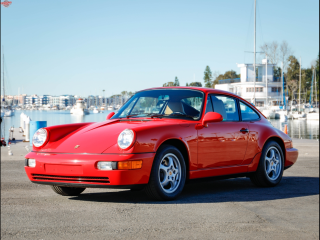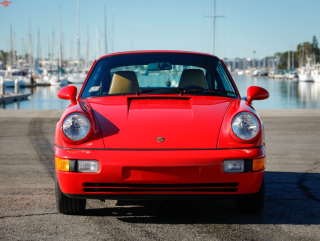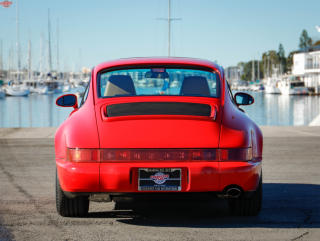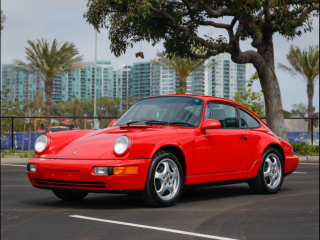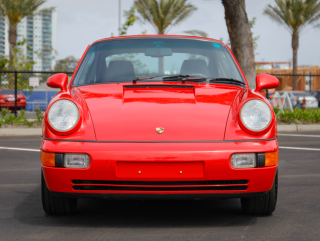The 1992 Porsche 911, part of the iconic 964 generation (1989-1994), is a rear-engine, two-door sports coupe renowned for its timeless design and exhilarating driving experience. Key trims include the Carrera 2 and the all-wheel-drive Carrera 4. It stands out for its evolutionary styling that paid homage to its predecessors while incorporating modern technology, cementing its status as a legendary performance car. New pricing varied significantly but was in the high $60,000s to over $70,000 range.
The Good
The 1992 911 boasts exceptional handling and a potent flat-six engine for thrilling drives. Its enduring design appeals emotionally, while its robust engineering offers surprising practicality and long-term value for discerning enthusiasts.
The Bad
Potential buyers should watch for oil leaks, particularly from the crankshaft seal and valve covers. The cooling fan and air conditioning systems can be prone to issues. Rust, especially around the wheel arches and sills, is also a concern.
1992 Porsche 911: Quick Overview
- Engine Options: The 1992 Porsche 911 primarily featured a 3.6-liter naturally aspirated flat-six engine.
- Horsepower: The Carrera 2 and Carrera 4 models typically produced around 247 horsepower.
- Fuel Economy: Expect EPA estimates in the range of 15-17 MPG city and 20-23 MPG highway. Real-world mileage can vary significantly based on driving style and conditions.
- 0-60 Times: 0-60 mph acceleration was generally in the 5.5 to 5.9-second range, depending on the specific trim and transmission.
- Towing Capacity: Towing capacity is not applicable for this performance-oriented sports car.
- Trim-Level Features:
Carrera 2 (Rear-Wheel Drive):
- Standard features often included power-adjustable seats, leather upholstery, a power sunroof, anti-lock brakes (ABS), and a premium sound system.
- Optional features could include air conditioning, cruise control, and a limited-slip differential.
- Included all the features of the Carrera 2, plus the advanced viscous coupling all-wheel-drive system for enhanced traction and stability.
- Often came with slightly wider bodywork compared to the Carrera 2.
- Optional features mirrored those of the Carrera 2.
1992 Porsche 911 Specifications
Vehicle Information
| Year | 1992 |
| Make | Porsche |
| Model | 911 |
| Trim | - |
| Style | - |
| Type | - |
| Category | - |
Manufacturing Details
| Made In | - |
| Manufacturing City | - |
Dimensions
| Doors | - |
| Curb Weight | - |
| Gross Vehicle Weight Rating | - |
| Overall Height | - |
| Overall Length | - |
| Overall Width | - |
| Wheelbase Length | - |
| Standard Seating | - |
Engine & Performance
| Engine | - |
| Engine Size | - |
| Engine Cylinders | - |
| Transmission | - |
| Transmission Type | - |
| Transmission Speeds | - |
| Drivetrain | - |
Additional Features
| Anti-Brake System | - |
| Steering Type | - |
Pricing
| Manufacturer Suggested Retail Price (MSRP) | - |
| Invoice Price | - |
| Delivery Charges | - |
Vehicle History Report
Vehicle
Specifications
Specifications
Ownership
History
History
All History
Events
Events
NMVTIS Title
History Check
History Check
Salvage/Rebuilt
Check
Check
Accident
Check
Check
Theft
Check
Check
Open Lien
Check
Check
Past Sale
Listings
Listings
Safety
Recalls
Recalls
Odometer
Check
Check
Market Price
Analysis
Analysis
What Problems Does the 1992 Porsche 911 Have?
The 1992 Porsche 911, while generally well-built, does have some commonly reported issues and long-term reliability concerns that owners and prospective buyers should be aware of. One of the most frequent complaints revolves around oil leaks. These can stem from several sources, including the crankshaft seal (often referred to as the 'wiped shaft seal' issue), valve cover gaskets, and oil cooler lines. Addressing these leaks can be costly, especially if the engine needs to be partially or fully removed. Another area of concern is the original plastic cooling fan and its housing, which can become brittle over time and crack, leading to overheating issues. Many owners opt to upgrade to more durable aluminum fans. The air conditioning system, particularly in older models, is also known to be finicky and can lose its effectiveness due to leaks in the hoses or compressor failures; significant repairs can be expensive. The ABS system, while advanced for its time, can also develop faults with age, particularly with the hydraulic pump or sensors. Regarding recalls, Porsche issued recalls for various 911 models across different years for issues that could include potential fuel leaks, airbag system anomalies (though less common on the 1992 model), or suspension components. It's crucial to check the specific VIN for any outstanding recalls. In terms of long-term reliability, the drivetrain is generally robust, but like any classic performance car, regular and meticulous maintenance is paramount. Neglected maintenance, especially on the engine and transmission, can lead to more significant and expensive problems down the line. While not specific to the 1992 model year, some 964 generation cars experienced issues with the transaxle seals, leading to potential leaks. Overall, while the 1992 911 can be a reliable car, it requires a more attentive owner than a modern vehicle, and budget for potential repairs is a wise consideration.
How long will the 1992 Porsche 911 last?
With proper and consistent maintenance, the 1992 Porsche 911 is capable of long-term durability, often exceeding 200,000 miles. Owner data suggests that vehicles driven regularly and serviced at reputable Porsche specialists can remain reliable for decades. However, the car's weaknesses, such as oil leaks and potential cooling system issues, can become more pronounced with age and higher mileage if not addressed proactively. While the core engine and transmission are robust, seals, gaskets, and accessory components will naturally wear over time, necessitating attention. Cars that have been meticulously maintained, with documented service history, tend to hold up better and offer a more predictable ownership experience. Conversely, neglected examples may present a cascade of issues as they age.
What Technology & Safety Features are Included?
The 1992 Porsche 911, while a performance icon, reflects the technological era it was born into, with a focus on driving dynamics rather than an abundance of high-tech gadgets. The standard entertainment system typically consisted of an AM/FM radio and cassette player, with optional upgrades to premium sound systems from brands like Blaupunkt or Bose being available. Bluetooth connectivity, touchscreens, or navigation systems were non-existent. The focus was on the auditory experience of the engine. In terms of driver-assistance features, the 1992 911 was quite minimalist. Anti-lock brakes (ABS) were standard, providing crucial assistance for braking control. Power steering was also standard for improved maneuverability. However, features like traction control, stability control, adaptive cruise control, lane departure warnings, or blind-spot monitoring were not part of the original offering. Safety features were centered on the robust chassis construction and basic passive safety. Standard safety equipment included three-point seatbelts, airbags for the driver and front passenger (though some early 964s had manual seatbelt adjusters, this was largely resolved by 1992), and crumple zones designed into the car's structure. Side-impact beams were also incorporated into the doors. Crash-test ratings for vehicles from this era are not as standardized or readily available as they are today. However, the 911 of this period was engineered with a strong emphasis on occupant protection for its class, utilizing its robust construction to absorb impact energy. The optional features were more geared towards enhancing the driving experience or comfort, such as a limited-slip differential for enhanced traction, heated seats, or cruise control. The built-in technology was functional but understated, prioritizing the raw driving experience over digital integration.
What Colors Options are Available?
1992 Porsche 911 Prices and Market Value
When new, the 1992 Porsche 911 retailed in the range of $65,000 to over $75,000, depending on the specific trim (Carrera 2 vs. Carrera 4) and optional equipment. As with most high-performance luxury vehicles, it experienced significant depreciation in its initial years. However, unlike many cars, the 911 has seen a remarkable resurgence in value in the collector market. Current used market prices for a 1992 Porsche 911 can range widely from $30,000 to $60,000+, with pristine, low-mileage examples, particularly rarer trims or those with desirable option combinations, fetching significantly higher figures. Factors affecting resale value include mileage, condition, maintenance history, originality, and market demand. The iconic status of the 911 and the increasing desirability of classic Porsches have driven up prices, making them a surprisingly strong investment for well-maintained examples.
1992 Porsche 911 Cost of Ownership
Owning a 1992 Porsche 911 is generally a costly endeavor. Insurance premiums will be higher than for a typical vehicle due to its performance and classic status. Fuel consumption, while not abysmal for its era, is still that of a performance car, so expect to spend more at the pump. Maintenance and repair costs are a significant factor; specialized Porsche mechanics are recommended, and parts can be expensive. Routine maintenance like oil changes and brake jobs will be pricier, and unexpected repairs, especially those involving engine or transmission work, can easily run into thousands of dollars. This is not an economical vehicle to own; it is a costly but rewarding passion purchase.
1992 Porsche 911 Fuel Efficiency
Fuel Type
-
Fuel Capacity
-
City Mileage
-
Highway Mileage
-
1992 Porsche 911 Recalls & Defects
Steering: Steering Wheel/Handle BAR
Recall date
1996-08-08
Recall no.
96v147000
Source
NHTSA
Summary
A Part OF THE Steering Column Upper Universal Joint Cracked During THE Manufacturing Process.
Consequence
This Condition Could Result IN Noise and Free Play IN THE Steering System and IF Left Uncorrected, Will Result IN Loss OF Steering Control.
Remedy
Dealers Will Inspect THE Universal Joint FOR Cracks and Will Replace Cracked Joints With NEW Parts.
Notes
Owner Notification:owner Notification IS Expected TO Begin During August 1996. Note:owners WHO Take Their Vehicles TO AN Authorized Dealer ON AN Agreed Upon Service Date and DO NOT Receive THE Free Remedy Within A Reasonable Time Should Contact Porsche AT 1-800-545-8039.also Contact THE National Highway Traffic Safety Administration's Auto Safety Hotline AT 1-800-424-9393.
Electrical System:wiring:fuses and Circuit Breakers
Recall date
1993-12-07
Recall no.
93v204000
Source
NHTSA
Summary
After THE Engine HAS Been Turned Off, THE Rear Heater Will Automatically Operate IN Order TO Dissipate Heat IN THE Engine Heating System. During This Operation, THE Resistor FOR THE Rear Heater Blower CAN Become Overloaded DUE TO A Binding or Seized Rear Heater Blower.
Consequence
THE Overloaded Resistor CAN Create Heat Sufficient Toignite THE Plastic AIR Pipe TO Which IT IS Connected, Resulting IN AN Enginecompartment Fire.
Remedy
Porsche Dealers Will Install A NEW Resistor Containing A Circuit Breaker.
Notes
System: Heater; Water; Defroster; Circuit Breaker.vehicle Description: Passenger Vehicles.note: IF Your Vehicle IS Presented TO AN Authorized Dealer ON AN Agreed Uponservice Date and THE Remedy IS NOT Provided Within A Reasonable Time and Freeof Charge or THE Remedy Does NOT Correct THE Defect or Noncompliance, Pleasecontact Porsche Service Center AT 1-800-545-8039. Also Contact THE Nationalhighway Traffic Safety Administration's Auto Safety Hotline AT 1-800-424-9393.
Service Brakes, Hydraulic:power Assist:vacuum:hoses, Lines/Piping, and Fittings
Recall date
1993-12-07
Recall no.
93v205000
Source
NHTSA
Summary
THE Hydraulic Brake Pressure Reduction Valve Causes THE Rate OF Hydraulic Pressure Reduction TO Slow Down, Which MAY Result IN THE Rear Wheels Locking-Up Even With THE Anti-Lock Brake System IN Operation.
Consequence
Rear Wheel Lock-Up MAY Result IN Loss OF Vehiclecontrol and AN Accident.
Remedy
Porsche Dealers Will Install A Modified Hydraulic Brake Pressure Reduction Valve.
Notes
System: Brakes; Hydraulic; Power Assist; Check Valve.vehicle Description: Passenger Vehicles; Models 911 Turbo and 911 Americaroadster.note: IF Your Vehicle IS Presented TO AN Authorized Dealer ON AN Agreed Uponservice Date and THE Remedy IS NOT Provided Within A Reasonable Time and Freeof Charge or THE Remedy Does NOT Correct THE Defect or Noncompliance, Pleasecontact Porsche Service Center AT 1-800-545-8039. Also Contact THE Nationalhighway Traffic Safety Administration's Auto Safety Hotline AT 1-800-424-9393.
Vehicle Speed Control
Recall date
1992-10-05
Recall no.
92v142000
Source
NHTSA
Summary
THE Ball Sockets ON THE Cruise Control Linkage CAN Break, Allowing THE Cruise Control Linkage TO Become Detached ON ONE END and JAM ON Nearby Components, Which Could Impair Throttle Plate Operation.
Consequence
Impaired Throttle Plate Operation Could Prevent Theengine From Returning TO Idle, Resulting IN Unwanted Engine Speed and Possiblevehicle Accident.
Remedy
Replace THE Current Plastic Ball Sockets With A NEW Linkage Using Steel Ball Sockets, and Lubricate THE Cruise Control Relay Lever. Owners ARE Advised NOT TO USE THE Cruise Control Until THE Modification IS Installed.
Notes
System: Cruise Control.vehicle Description: Passenger Cars; Carrera 2 and Carrera 4 Models.
1992 Porsche 911 Insurance
Insurance for a 1992 Porsche 911 is moderately priced, reflecting its status as a Vehicle with strong safety ratings and
reasonable repair costs.
reasonable repair costs.
How Does the 1992 Porsche 911 Compare to Other Vehicle?
The 1992 Porsche 911 competed in a rarefied segment of the sports car market. Its closest rivals in terms of performance and prestige were the Chevrolet Corvette C4 ZR-1 and the Ferrari 348.
In terms of performance, the 911's naturally aspirated flat-six engine delivered a distinctive power band and razor-sharp handling, particularly lauded for its rear-engine dynamics. The Corvette ZR-1, with its potent V8, offered brute force and straight-line acceleration that often surpassed the 911, though its handling was considered less refined by some. The Ferrari 348, while exotic, was often criticized for its less engaging handling compared to the 911 and its reliability concerns.
For features, the 911 offered a functional, driver-focused interior. The Corvette provided more creature comforts and a wider range of electronic features for its price point. The Ferrari, as a true supercar, emphasized driving purity with fewer modern amenities.
Regarding reliability, the 1992 Porsche 911, while requiring diligent maintenance, was generally considered more reliable than the Ferrari 348, which suffered from numerous mechanical issues and a demanding maintenance schedule. The Corvette C4, particularly the ZR-1, was a more modern and complex machine that could also present its own set of issues, but generally leaned towards robust American engineering.
In terms of price, the 1992 911 was positioned between the Corvette and the Ferrari. The Corvette was significantly more affordable, offering exceptional performance for the money. The Ferrari 348 was considerably more expensive, commanding a premium for its exotic badge and styling.
Alternatives:
Ultimately, the 1992 Porsche 911 offered a compelling blend of performance, heritage, and driving engagement that few rivals could match, especially when considering its growing collector status.
In terms of performance, the 911's naturally aspirated flat-six engine delivered a distinctive power band and razor-sharp handling, particularly lauded for its rear-engine dynamics. The Corvette ZR-1, with its potent V8, offered brute force and straight-line acceleration that often surpassed the 911, though its handling was considered less refined by some. The Ferrari 348, while exotic, was often criticized for its less engaging handling compared to the 911 and its reliability concerns.
For features, the 911 offered a functional, driver-focused interior. The Corvette provided more creature comforts and a wider range of electronic features for its price point. The Ferrari, as a true supercar, emphasized driving purity with fewer modern amenities.
Regarding reliability, the 1992 Porsche 911, while requiring diligent maintenance, was generally considered more reliable than the Ferrari 348, which suffered from numerous mechanical issues and a demanding maintenance schedule. The Corvette C4, particularly the ZR-1, was a more modern and complex machine that could also present its own set of issues, but generally leaned towards robust American engineering.
In terms of price, the 1992 911 was positioned between the Corvette and the Ferrari. The Corvette was significantly more affordable, offering exceptional performance for the money. The Ferrari 348 was considerably more expensive, commanding a premium for its exotic badge and styling.
Alternatives:
- Similar: The Lotus Esprit offered exotic styling and excellent handling, though its turbocharged engine and French mechanical components could lead to reliability headaches.
- Higher Performance/Exotic: The aforementioned Ferrari 348, or slightly later models like the Ferrari F355, offered more dramatic styling and exotic appeal but at a higher price and with potentially greater maintenance risks.
- More Affordable Performance: The Nissan 300ZX Twin Turbo (Z32) offered impressive performance and advanced technology for its time at a much lower price point, though it lacked the iconic status and handling purity of the 911.
Ultimately, the 1992 Porsche 911 offered a compelling blend of performance, heritage, and driving engagement that few rivals could match, especially when considering its growing collector status.
Final Verdict: Is the 1992 Porsche 911 a Good Vehicle?
The 1992 Porsche 911 is ideal for the passionate automotive enthusiast who appreciates timeless design, engaging driving dynamics, and the allure of a classic sports car icon. It is a car that rewards a driver's skill and offers a visceral connection to the road.
Whether it's worth buying depends heavily on the individual's budget and tolerance for potential maintenance costs. If approached with a realistic understanding of ownership expenses, it can be a worthwhile investment, especially for well-maintained examples. Buying used is the only option, and prioritizing cars with comprehensive service histories, preferably from reputable Porsche specialists, is crucial. Specific trims like the Carrera 4 offer enhanced all-weather capability, while the Carrera 2 provides a purer RWD experience. Ultimately, it's for someone who values heritage and driving purity over modern conveniences and is prepared for the responsibilities of owning a classic performance vehicle.
Whether it's worth buying depends heavily on the individual's budget and tolerance for potential maintenance costs. If approached with a realistic understanding of ownership expenses, it can be a worthwhile investment, especially for well-maintained examples. Buying used is the only option, and prioritizing cars with comprehensive service histories, preferably from reputable Porsche specialists, is crucial. Specific trims like the Carrera 4 offer enhanced all-weather capability, while the Carrera 2 provides a purer RWD experience. Ultimately, it's for someone who values heritage and driving purity over modern conveniences and is prepared for the responsibilities of owning a classic performance vehicle.
